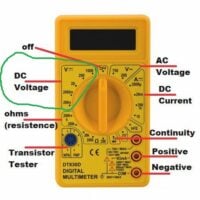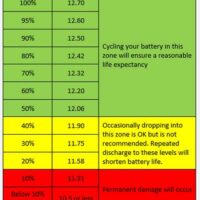OK so I got a new trolling motor installed as well as 2 New Deep cycle and 1 new cranking battery. Still seem to be having some issues with the onboard 2 bank charger that is hooked to the Trolling motor deep cycle batteries. I need to verify if the onboard charger is indeed supplying a charge to both Batteries or not. With a multimeter, what is the easiest way to do so. What setting on the multimeter should I use and what am I looking for it to tell me? The onboard charger is a 10Amp 2 bank charger if that info is needed. Even though the indicator lights seem to be hit or miss, I think the charger is still working correctly and charging both batteries like it should. After dropping the $ for a new Terrova and 3 new batteries, I really don’t feel like replacing the onboard charger right now unless I really have to. Thanks in advance for all the reply’s.
IDO » Forums » Fishing Forums » General Discussion Forum » More electric help for the electric Idiot
More electric help for the electric Idiot
-
August 8, 2023 at 1:02 pm #2218047
1. Unplug the charger. Let the batteies rest a for 2 hours.
2. Set the multimeter on “VOLTAGE”, typically to the 20V scale.
3. Red to positive terminal, black to negative, touch the probes to the battery terminals. Remember the voltage reading.
4. Repeat on each battery.
5. Reconnect the charger and compare the voltage readings for each battery.Resting voltage of a fully charged battery should be around 12.7 Volts; with the charger on you should see 13 to possibly 15 Volts, depending on the charger.
You might want to check voltage before and after every outing as I’m not sure a 10-amp charger is good enough for 3 batteries. Depends on the charger.August 8, 2023 at 1:14 pm #22180481. Unplug the charger. Let the batteies rest a for 2 hours.
2. Set the multimeter on “VOLTAGE”, typically to the 20V scale.
3. Red to positive terminal, black to negative, touch the probes to the battery terminals. Remember the voltage reading.
4. Repeat on each battery.
5. Reconnect the charger and compare the voltage readings for each battery.Resting voltage of a fully charged battery should be around 2.70 Volts; with the charger on you should see 13 to possibly 15 Volts, depending on the charger.
You might want to check voltage before and after every outing as I’m not sure a 10-amp charger is good enough for 3 batteries. Depends on the charger.So I checked the voltage on Both Batteries after the Onboard charger showed them fully charged. Both read right around 12.8. So later today if I plug in the onboard charger the voltage should read a fair amount higher if the charger is indeed charging the batteries.
August 8, 2023 at 1:16 pm #2218049Just to add a few items meter set to DC Voltage. Also Ron says 2.70 he meant 12.7.
Just like testing your car alternator take the voltage of the battery at rest then plug charger in and take the voltage readings they should be increasing or at least greater then the resting voltage. Included a picture to show where your dial should be set and where your cables should be plugged into.
August 8, 2023 at 1:20 pm #2218051<div class=”d4p-bbt-quote-title”>Ron wrote:</div>
1. Unplug the charger. Let the batteies rest a for 2 hours.
2. Set the multimeter on “VOLTAGE”, typically to the 20V scale.
3. Red to positive terminal, black to negative, touch the probes to the battery terminals. Remember the voltage reading.
4. Repeat on each battery.
5. Reconnect the charger and compare the voltage readings for each battery.Resting voltage of a fully charged battery should be around 2.70 Volts; with the charger on you should see 13 to possibly 15 Volts, depending on the charger.
You might want to check voltage before and after every outing as I’m not sure a 10-amp charger is good enough for 3 batteries. Depends on the charger.So I checked the voltage on Both Batteries after the Onboard charger showed them fully charged. Both read right around 12.8. So later today if I plug in the onboard charger the voltage should read a fair amount higher if the charger is indeed charging the batteries.
The easiest way to check them is while they are charging. You might want to run the batteries down a bit that way you can check the voltage on the batteries while they are charging. Go out fishing check battery voltage once you return then plug charger in and see if the voltage is increasing. If it is on the batteries then the charger is working.
August 8, 2023 at 1:41 pm #2218052Ok I edited my post to change 2.70 to 12.7. Thanks for catching that, Supercat. I know I checked twice before I posted, but missed it.

 CaptainMusky
Posts: 19397August 8, 2023 at 1:53 pm #2218058
CaptainMusky
Posts: 19397August 8, 2023 at 1:53 pm #2218058Ok I edited my post to change 2.70 to 12.7. Thanks for catching that, Supercat. I know I checked twice before I posted, but missed it.

Don’t worry Ron. I assumed that you intended it to say 12.7.
August 8, 2023 at 1:56 pm #2218059I kind of thought that would work to check the voltage while the charger was plugged in. Just not sure. I did to try to check the voltage with it plugged in and there did not seem to be a difference, But it may have been that since they were fully charged the charger was not sending a charge to them at the moment that I checked.
August 8, 2023 at 2:31 pm #2218060I kind of thought that would work to check the voltage while the charger was plugged in. Just not sure. I did to try to check the voltage with it plugged in and there did not seem to be a difference, But it may have been that since they were fully charged the charger was not sending a charge to them at the moment that I checked.
Correct.
August 8, 2023 at 4:28 pm #2218071Here’s a useful chart for lead-acid batteries. Lithiums are a different animal.
August 9, 2023 at 9:53 pm #2218261So I did as people suggested. After using the trolling motor a fair amount yesterday I let the batteries sit till this afternoon. When checked with my multimeter battery 1 read 12.64 and battery 2 read 12.57. I plugged in the onboard charger and Checked the voltage again and battery 1 was reading 13.40 and battery 2 was 13.20. So the charger appears to be working correctly. After the charger read fully charged battery 1 read 12.9 and Battery 2 was 12.8. Interesting development in the issue. Prior to charging the batteries I plugged the retractable cord I normally use to plug the charger into in my pellet grill and noticed the plug seemed really loose. I have noticed when plugging into the charger that the connection also seemed rather loose fitting. I decided to use a different extension cord to plug in the charger. This plug in seemed much tighter and both lights on the onboard charger came right on. I think the loose plug on the retractable cord may be part of my issue. I guess I will see if the charger lights correctly next charging.
August 10, 2023 at 7:53 am #2218284So I did as people suggested. After using the trolling motor a fair amount yesterday I let the batteries sit till this afternoon. When checked with my multimeter battery 1 read 12.64 and battery 2 read 12.57. I plugged in the onboard charger and Checked the voltage again and battery 1 was reading 13.40 and battery 2 was 13.20. So the charger appears to be working correctly. After the charger read fully charged battery 1 read 12.9 and Battery 2 was 12.8. Interesting development in the issue. Prior to charging the batteries I plugged the retractable cord I normally use to plug the charger into in my pellet grill and noticed the plug seemed really loose. I have noticed when plugging into the charger that the connection also seemed rather loose fitting. I decided to use a different extension cord to plug in the charger. This plug in seemed much tighter and both lights on the onboard charger came right on. I think the loose plug on the retractable cord may be part of my issue. I guess I will see if the charger lights correctly next charging.
Yes it sounds like everything is working correctly and even fixed one thing that you didn’t know was causing a problem. Well at least you have new batteries.
August 10, 2023 at 12:07 pm #2218330What are you running for electronics on your starting battery? Unless you make a lot of long runs I would keep an eye on state of charge of this battery.
August 10, 2023 at 12:14 pm #2218331What are you running for electronics on your starting battery? Unless you make a lot of long runs I would keep an eye on state of charge of this battery.
The only thing hooked to my Starting battery is the starting of the 150 Motor and 2 Old school Lowrance HDS units. I often put that battery on a manual charger from time to time. The alternator does a decent job of keeping the cranking battery charged. I just give it a full charge every few outings.
August 10, 2023 at 2:25 pm #2218348I often put that battery on a manual charger from time to time. The alternator does a decent job of keeping the cranking battery charged. I just give it a full charge every few outings.
[/quote]
You don’t really know what the status of your battery is. Many years ago, when I was much younger and much more foolish, I had a friend with a boat on Lake Michigan who took us salmon fishing a few times. We all knew he was an “electrical idiot”, as you describe yourself, but we just shook our heads and went fishing with him. One day when we were ready to return to shore, one of the twin 80’s had a dead battery. Rope-starting that motor involved a lot of cursing. I wouldn’t want to try it with a 150.
I’d suggest laminating the chart I posted earlier and keeping it in your boat (mine’s taped inside the battery compartment lid). It’s not a bad idea to check battery voltage before you launch. Additional draws on your starter battery could include bilge pump, livewell pump, lights and accidentally leaving one of those switches on. And every time you return from fishing, compare your starter battery voltage with the chart until you have a good idea how much you’re drawing it down. The goal is to have a solid confidence in the condition of your batteries so you won’t ever wonder if you’ll make it back home.August 10, 2023 at 2:36 pm #2218351It was worth getting out of bed today. I learned something and got a handy chart.
I will add. I have the same terrova set up. And I do put the starting/accessories battery on charger once in awhile. I do carry a Lithium jumper in the boat just in case my starting battery needs it. I never needed it, but I helped a guy out once. Worthwhile $75 investment.
August 10, 2023 at 3:06 pm #2218355Or carry a noco.
I did purchase one of those last year. It currently is in my wife’s car. I will make sure to bring that with on my Canada Trip for sure. Also carry a set up Jumper cables in the boat as well.
August 10, 2023 at 3:12 pm #2218358<div class=”d4p-bbt-quote-title”>Eelpoutguy wrote:</div>
Or carry a noco.I did purchase one of those last year. It currently is in my wife’s car. I will make sure to bring that with on my Canada Trip for sure. Also carry a set up Jumper cables in the boat as well.
I bought one of those last year too, or should I say received it as a gift. And I also have jumper cables too. Haven’t used the noco yet either other than the USB port to charge a cell phone.
August 10, 2023 at 3:29 pm #2218360I set up the overlay displays on my graph to show the starting battery voltage along with water temp, time of day, etc. I think most mid-level or higher graphs have that capability. It’s an easy way to keep an eye on the status of the battery.
August 10, 2023 at 3:47 pm #2218362I set up the overlay displays on my graph to show the starting battery voltage along with water temp, time of day, etc. I think most mid-level or higher graphs have that capability. It’s an easy way to keep an eye on the status of the battery.
My graph will show the Voltage. I guess I could add it to the overlay, Not real sure. Its simple enough to go to the status screen and check it.
August 10, 2023 at 3:57 pm #2218364I think you guys might be over thinking this. Sounds like the main concern is if the charger indicator lights are working.
If this were me (and I have been in this “boat”) I’d go out and run the batteries down. Both the T-motor and starter. (For the starter, just run some accessories like the lights/radio for a couple hours after you get off the water.)
Then check the battery voltage. Note the readings. Then charge. After the charge, check the voltage. All should be the same for a new battery.
If the charger light indicates full charge and stop charging and goes into maint mode. All good.
If the charger never finishes the charge, you have a problem. Replace the charger. The main reason is you don’t want a charger that keeps charging a full battery. This will kill the battery in short order.
-J.
You must be logged in to reply to this topic.

